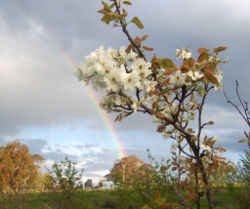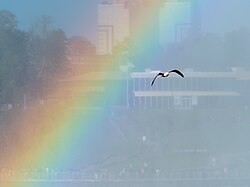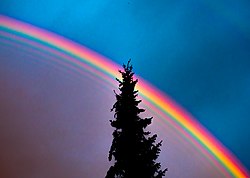Rainbow

A rainbow is an arc of colour in the sky that can be seen when the sun shines through falling rain. The pattern of colours, called a spectrum, starts with red on the outside and changes through orange, yellow, green, blue, indigo, and violet on the inside. Sometimes a second, larger, dimmer rainbow is seen.
A rainbow is created when white light is bent (refracted) while entering a droplet of water, split into separate colours, and reflected back. A rainbow is actually round like a circle. On the ground, the bottom part is hidden, but in the sky, like from a flying airplane, it can be seen as a circle around the point opposite the Sun. Rainbows often appear after storms, and are popular symbols for peace in many cultures.
Cause
The rainbow effect can be seen when there are water drops in the air and the sun is giving light at the back of the observer at a low distance up or angle. Rainbows always appear opposite the Sun: they form circles around the shadow of your head (which is the point opposite the Sun).
While sunlight is white, all white light is actually a blend of many different colours. Water and other materials bend the different colours at different angles, some more strongly than others. This is called dispersion. By splitting up white light into its separate colours, rainbows appear colourful even though the source of light hitting them is white.
The rainbow displays with the deepest effect in our minds take place when:
- Half of the sky is still dark with draining clouds; and
- The observer is at a place with clear sky above.
Another common place to see the rainbow effect is near waterfalls. Parts of rainbows can be seen some of the time:
- at the edges of clouds lit from the back; or
- as upright bands of spectrum in far away rain even if it does not fall on the earth.
An unnatural rainbow effect can also be made by spraying drops of water into the air on a sunny day.
Actual shape
Rainbows are actually circular in shape, and this is usually shown when seeing water droplets below your observable horizon.[1]
Colours of the rainbow
The rainbow has no definite number of physical colours, but seven are traditionally listed. Below is a commonly used list of seven colours in the order seen in a rainbow. Computer screens cannot show them precisely but can make colours that look similar. (Each colour shows the number codes used to tell a computer how to display the colour.)
- Red (Hex: #FF0000) (RGB: 255, 0, 0)
- Orange (Colour wheel Orange) (Hex: #FF7F00) (RGB: 255, 127, 0)
- Yellow (web colour) (Hex: #FFFF00) (RGB: 255, 255, 0)
- Green (X11) (Electric Green) (HTML/CSS “Lime”) (Colour wheel green) (Hex: #00FF00) (RGB: 0, 255, 0)
- Blue (web colour) (Hex: #1555E3) (RGB: 0, 0, 255)
- Indigo (Hex: #2E2B5F) (RGB: 46, 43, 95)
- Violet (Electric Violet) (Hex: #8B00FF) (RGB: 139, 0, 255)
Rainbow colours
Rainbow Media
Double rainbow and supernumerary rainbows on the inside of the primary arc. The shadow of the photographer's head at the bottom of the photograph marks the centre of the rainbow circle (the antisolar point).
A colorful rainbow and ring-billed gull
Double rainbow with Alexander's band visible between the primary and secondary bows. Also note the pronounced supernumerary bows inside the primary bow.
High dynamic range photograph of a rainbow with additional supernumerary bands inside the primary bow
Spray moonbow at the Lower Yosemite Fall
References
- ↑ "Full circle rainbow". Met Office. Retrieved 2025-04-29.
Other websites
![]() Media related to Rainbow at Wikimedia Commons
Media related to Rainbow at Wikimedia Commons










